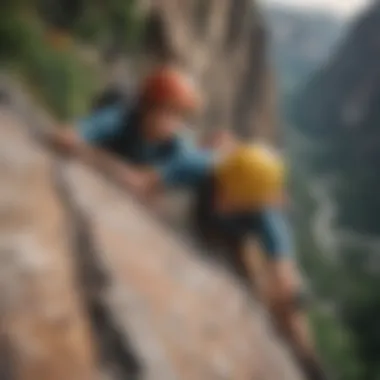Exploring High Adventure Summer Camps: A Deep Dive


Overview of the Topic
Intro
High adventure summer camps are not just a seasonal escape; they embody a significant educational approach focusing on various aspects of the environment and individual growth. Such camps often blend outdoor activities with learning experiences, encouraging particpants to cultivate important skills like teamwork, leadership, and resilience.
These experiences have proven invaluable, especially as concerns regarding environmental sustainability become paramount. This rising awareness makes high adventure camps relevant, imparting lessons that address crucial resource management and conservation issues. They reflect a growing need to foster connections between young individuals and the natural world, helping them become conscientious stewards of the Earth.
Key Objectives and Activities
High adventure summer camps pursue diverse goals, ranging from building young people's confidence to developing physical and social skills. Activities like rock climbing, canoeing, and wilderness survival not only tackle participants’ physical limits but also emphasize teamwork and perseverance.
Skills Gained
The skills participants can expect to gain from these camps are numerous, including:
- Leadership: Guiding peers during group activities.
- Problem-solving: Navigating unexpected challenges in an outdoor setting.
- Environmental stewardship: Understanding the significance of conservation through direct engagement with natural ecosystems.
Personal Growth and Environmental Awareness
Participating in high adventure summer camps leads to a profound sense of personal growth. Campers obtain a deeper understanding of their abilities and limitations.
Developing environmental awareness is equally significant. Encounters with nature inspire campers to appreciate ecosystems, motivating them to prioritize sustainability and proactive conservation methods as they grow.
“Experiencing nature first-hand cultivates respect for it, enhancing a deep-rooted awareness that influences future decisions regarding resource use.”
Addressing Challenges and Threats
While these camps offer numerous benefits, campers also face challenges that cannot be underestimated. Weather-related issues, physical accidents, and environmental impacts are notable factors influencing camp management.
Solutions to Overcome Challenges
To address these challenges, camp organizers have developed various solutions, such as:
- Rigorous training for staff on risk management and emergency protocols.
- Implementing education about local wildlife and ecosystems to minimize human impact.
- Offering Pre-camp orientation sessions for both campers and their parents, ensuring thorough understanding of potential risks.
Ending
High adventure summer camps represent dynamic learning environments integrating personal growth with environmental consciousness. They fill essential gaps in modern outdoor education by providing practical experiences and insights into conservation efforts. In return, they properly equip the youth with necessary awareness and knowledge for sustainable practices in the face of today's pressing resource management challenges.
Prolusion to High Adventure Summer Camps
High adventure summer camps play a vital role in developing important skills and instilling a deep respect for the environment among young individuals. As society increasingly faces challenges such as climate change and natural resource depletion, these camps provide unique opportunities for participants to engage meaningfully with nature while learning crucial life skills. Understanding high adventure camps in depth may inform how such programs can influence individual growth and environmental stewardship in today’s world.
Definition and Overview
High adventure summer camps are specialized outdoor programs focused on thrilling experiences paired with skill development in various adventure sports. While traditional summer camps might concentrate on arts and crafts or basic recreation, high adventure camps are aimed at fostering skills like rock climbing, canoeing or backpacking. These camps typically cater to teenagers and young adults, offering them the chance to develop physically, mentally and socially in an active environment.
Typically, these camps embrace safety and personal growth, making rigorous efforts to balance adventure with participant security. This focus ensures that campers feel not only exhilarated but also grounded in practical safeguarding practices.
Historical Context
The origins of high adventure summer camps can be traced back to the 1960s, a time when outdoor education gained traction in the United States. It has roots in the notion of experiential education, championing the idea that learning is most effective when immersed in real-world experiences. Groups focused on environmental issues began to organize activities that ranged from wilderness survival to conservation efforts. Over the decades, these programs evolved into curated experiences that focused not just on adventure, but also on educating participants about their ecological impact.
Not only are these camps crucial to conditioning physical abilities; they also aim to ground participants in appreciation for nature. As more people see benefits of these unique educational settings, high adventure summer camps continue to blossom in various forms around the world.
Key Objectives of High Adventure Camps
High adventure summer camps serve various critical objectives that align with personal development and environmental consciousness. These goals extend far beyond mere recreational activities and immerse participants in experiences that contribute to both individual growth and a greater appreciation of the planet.
Skill Development
Skill development plays a central role in the curriculum of high adventure summer camps. Participants are exposed to numerous opportunities to cultivate essential competencies which influence their personal and social capabilities in various ways.


Leadership Skills
In programs focused on cultivating leadership skills, campers learn to take initiative and make decisions for themselves and others. They engage in activities that require assessing situations, forming strategies, and guiding peers. This is intrinsic to creating confident individuals who can navigate complex social dynamics.
What makes leadership skills so conducive to personal development is the emphasis on understanding interpersonal relationships. Campers are pushed to step out of their comfort zones and take charge when necessary. This skill invites responsibility, fostering a sense of accountability in participants. Moreover, these lessons are often transferable, significantly benefiting campers in their future pursuits, from academics to career paths.
Teamwork and Collaboration
Teamwork and collaboration are equally indispensable in the high adventure camp setting. These camps expect participants to engage frequently with their peers, developing an understanding of cooperative efforts needed to achieve common goals. The central idea is that working closely with diverse individuals fosters respect, understanding, and optimized group processes.
The feature of teamwork extends beyond simply getting along with others. It relies on effective communication, problem solving, and conflict resolution. Understanding how to harmonize one's strengths with those of others is achvaluable. These skills are pivotal in both community relationships and professional environments. However, this dynamic could at times lead to conflicts, as not every personality blends seamlessly. Such challenges, when navigated, offer great learning and improvement opportunities.
Environmental Awareness
Fostering environmental awareness is one of the defining aspects of high adventure summer camps. This objective can bolster future generations' commitment to sustainability. As participants engage with nature, they learn about ecosystems, conservation practices, and the vital role humans play in the environment.
At high adventure camps, lessons on ecology and environmental stewardship are not abstracts; they are rooted in direct experience. Whether hiking through dense forests or canoeing on serene lakes, campers gain firsthand knowledge. Engaging with nature brings these concepts to life.
Overall, cultivating this awareness has public benefits. Generating a sense of stewardship in youth can lead to more sustainable behaviors in adulthood.
The fusion of skill development and environmental education prepares participants comprehensively. They leave these camps equipped to contribute positively to society and the world, making informed decisions about both their lives and the places they inhabit.
Activities Offered at High Adventure Camps
High adventure summer camps provide diverse activities designed to foster personal growth, physical fitness, and environmental awareness. The activities offered help campers assess their skills and confront their limits in a supportive environment. High adventure camps not only foster healthy competition but also nurture an appreciation for the outdoors. The experiences gained during these activities often shape participants into more socially aware and self-confident individuals.
Outdoor Exploration
Outdoor exploration is central to the mission of high adventure camps. It encourages participants to discover natural landscapes, flora, and fauna. Activities such as hiking, camping, and canoeing provide firsthand experience of these environments. By being immersed in nature, campers develop a genuine connection to the world around them. Moreover, exploring the outdoors cultivates essential skills, including navigation and observation.
Fitness and Physical Activities
Hiking
Hiking is an integral activity that combines physical fitness with exploration. It enhances cardiovascular health and develops muscular endurance. The key characteristic of hiking is its accessibility; it can be tailored for various skill levels. This adaptability makes it a frequently chosen activity in summer camps. Unique to hiking is its ability to connect participants with nature while promoting solitude and reflection.
The advantages of hiking include its low entry barrier. Campers of all age and fitness levels can take part, allowing for shared experiences. However, the disadvantage may arise if participants underestimate their physical capability, leading to fatigue or injury. Overall, hiking nurtures physical health while promoting mental clarity.
Rock Climbing
Rock climbing is both exhilarating and challenging. Its contribution to skill development is significant— from problem-solving abilities to fostering determination. The foundational characteristic of rock climbing is precision; every movement requires focus and deliberation. It is a popular choice in high adventure programs due to its thrill and rewards.
Each ascent presents a unique feature, testing a camper both physically and mentally. Rock climbing offers advantages, such as increased strength and improved confidence. The drawbacks can include risks of injury, especially for inexperienced climbers who may not follow safety protocols.
Canoeing
Canoeing provides a calm yet invigorating way to experience water bodies. This activity emphasizes cooperation and coordination between campers. The primary characteristic of canoeing lies in teamwork; it requires participants to work harmoniously to navigate efficiently. This makes it beneficial for developing relationships in a group dynamic even outside of traditional competition.
The unique feature of canoeing is its tranquil pace, allowing exploration at leisure. Despite its many benefits, such as increased upper body strength and balance, challenges may arise in inclement weather, which can affect the overall experience in the water.
Team-Building Exercises
Team-building exercises are an important component of high adventure camps. These activities promote collaboration, communication, and trust among participants. Group challenges may include obstacle courses, trust falls, and various problem-solving tasks. The enriching experiences foster ties among campers as they work together to achieve common goals. Real-life applications of these team-building skills often transcend camp experiences, impacting social relations and work dynamics long afterwards.
Benefits of High Adventure Camps
High adventure summer camps provide various advantages that extend beyond traditional camping experiences. Recognizing their benefits is important within this article. This section elaborates on personal growth, social connections, and physical health improvements that campers can gain while attending such programs.
Personal Growth
Self-Confidence
Self-confidence develops through experiences that challenge traditional limits. At high adventure camps, participants engage in activities that push personal boundaries. Unfamiliar environments call for adaptability, boosting self-esteem as campers overcome obstacles. The sense of accomplishment after scaling a rock face or navigating a rough river plays a crucial role. This characteristic of self-confidence also fosters independence, making it beneficial in personal and professional life.


Uniquely, self-confidence nurtures decision-making skills as individuals learn to trust their instincts in unfamiliar surroundings. As a notable benefit, enhanced self-confidence can lead to a lifelong pursuit of challenges. Campers become more open to taking calculated risks, affecting their futures positively.
Resilience
Resilience is the ability to recover quickly from difficulties. This quality is essential for participants, especially in high-pressure situations common in adventure camps. Faced with a daunting hike or a tricky climbing course, participants learn to navigate both successes and setbacks, cultivating a formidable psychological stamina. This resilience matters, providing life skills that further relate to the ever-changing landscape of personal experiences.
Pertinently, resilience and adaptability intertwine, enabling individuals to adjust to obstacles without losing motivation. Emotional regulation often grows as campers learn to face fears head-on. The unique feature of resilience acquired at high adventure camps distinctly benefits profound character building, helping the campers become strong individuals.
Social Connections
Social connections created in high adventure camps often have lasting effects. Engaging in group activities generates camaraderie. Participants must rely on one another within team-based adventures, cultivating relationships founded on trust and mutual understanding. These connections often extend beyond the camp, leading to lifelong friendships.
Friendship built under pressure provides memories and lessons, enriching one’s social life enough to foster a sincere community spirit. Moreover, the experience of shared struggles and triumphs can create networks that serve both social and professional tastes.
Physical Health Improvements
Physical health improvements serve as another significant benefit of high adventure camps. Activities like hiking, rock climbing, and canoeing provide extensive cardiovascular exercises. Participation inevitably increases fitness levels. A healthy and active lifestyle emerges from these sessions, translating to long-term wellness.
Importantly, these physical demands encourage healthy habits. As individuals grow stronger and more coordinated, they become keenly aware of their body's capabilities. A surge in physical activity fosters fitness appreciation and may lead into healthier lifestyle choices even after camp concludes.
Quote: > "High adventure camps teach that limitations often exist only in one’s mind. Enhancing personal potential outside established boundaries is knowledge that is indispensable."
As camps continue to thrive within communities, understanding their benefits offers valuable insights for those seeking meaningful experiences. The combination of personal growth, social bonding, and physical enhancement exemplifies integral aspects crucial to the evolving narrative of modern education.
Environmental Impact of High Adventure Camps
High adventure summer camps play a significant role in shaping not only young individuals but also the environment. With increasing concerns about preservation and sustainability, understanding the environmental impact of these camps is crucial for both attendees and educators alike. This section discusses the importance of sustainable practices and conservation education, which form the core of how these camps approach environmental stewardship.
Sustainable Practices
Sustainable practices in high adventure camps is aimed at minimizing the footprint of camp activities. Crrent methods indicate a commitment to protecting the natural environment while ensuring the experiences offered are enriching. Key aspects include:
– Waste Reduction: Campers are often encouraged to reduce waste through recycling, reusing materials, and composting organic waste.
– Resource Management: Effective use of natural resources—such as water and energy—principles assist in maintaining ecological balance. For instance, using solar power systems for lighting and activities prevents reliance on non-renewable sources.
– Leave No Trace philosophy: This principle teaches campers to leave the area they visit as undisturbed as possible. This not only preserves nature but also enhances campers’ respect for their surroundings.
– Eco-Friendly Gear: Promoting the use of sustainable outdoor attire and equipment can significantly reduce environmental harm. Selecting biodegradable or recyclabke options is integral.
These sustainable practices can help foster awareness of environmental issues while equipping future generations with the necessary skills to protect natural resources.
Conservation Education
Conservation education is a vital component of the high adventure experience. Campers gain insights on how different environments function and the importance of protecting these areas. Education in this realm may cover:
- Local Ecosystems: Understanding various ecosystem components—including species interactions and biodiversity—is fundamental.
- Threats to the Environment: Many camps explain the various threats such as pollution or climate change, aiming to cultivate a sense of urgency about planetary care.
- Community Engagement: Involving campers in local conservation efforts encourages volunteering. This engagement connects them with local wildlife that sustains crops and improves human livelihood.
- Hands-On Learning: By participating in action-centered activities—like building trails or tree planting—campers learn the practical applications of conservation concepts.
By prioritizing both sustainable practices and conservation education, high adventure summer camps become influential in shaping ecologically conscious individuals. It equips young adventurers with knowledge, values, and skills essential for future ecological sustainability.
The impact of a generation nurtured in high adventure camps extends well beyond their time there; it ripples across communities and ecosystems globally.
Challenges Participants May Face
Engaging in high adventure summer camps offers innumerable benefits, but it also involves a set of challenges that participants must navigate. Understanding these challenges ensures comprehensive preparation and helps individuals make the most out of their camp experience. Navigating physical and mental strain along with group dynamics can significantly influence the overall enjoyment and learning outcomes at these camps.
Physical and Mental Strain
Attending a high adventure camp demands physical stamina and mental resilience. Participants often find themselves in scenarios that push them beyond their usual limits. For the body, activities like hiking, climbing, and canoeing can lead to fatigue, aches, or even minor injuries. This aspect of physical strain emphasizes the need for proper conditioning before participating in such camps.
Mentally, the challenges can be equally daunting. The pressure of facing unfamiliar environments or tackling new skills can manifest in anxiety or stress. It is critical for participants to have coping strategies in place.
Some effective strategies include:
- Setting personal goals
- Practicing mindfulness techniques
- Utilizing supportive camp leadership
Ultimately, cultivating both physical endurance and mental fortitude proves essential for a successful camp experience.
“Endurance is not just in the body; it’s in the mind as well.”
Group Dynamics


The dynamics of group interaction plays a vital role in the high adventure camp experience. When a group comes together to face difficult tasks, varying personalities and temperaments can surface. Participants must learn to navigate these differences in order to foster a cohesive environment. Sometimes conflicts can arise from competition or misunderstandings, which can color the overall experience of all involved.
To enhance positive group dynamics, several elements come into play:
- Effective communication skills can facilitate better understanding.
- Collaborative team activities help build trust and rapport.
- Conflict resolution strategies empower campers to handle disagreements in constructive ways.
By attending to these dynamics, participants learn valuable social skills that can serve well beyond their time at the camp. Striving for harmony within a groups leads always to more successful adventures.
Understanding the challenges involved in high adventure summer camps is essential. Preparing for these physical and mental demands, as well as enhancing group interactions, ensures participants gain the most from their experiences while developing critical life skills.
Selecting a High Adventure Camp
Choosing the right high adventure camp is crucial for both participants and their guardians. The decision involves careful consideration of various elements that significantly affect the camp experience. Identifying the right fit not only maximizes the opportunity for growth but also ensures safety and satisfaction. This section will breakdown key factors to consider when selecting a camp, and emphasize their relevance to the camp's overall essence.
Factors to Consider
Location
The location of a summer camp plays an essential role in the overall experience. Camps situated in national parks, wilderness areas, or near lakes tend to draw participants for their unique offerings. A mountainous region might attract those interested in rock climbing or hiking, while a lakeside camp may offer kayaking and canoeing.
A prime factor in determining a suitable location incldes accessibility. Many families prefer camps closer to their home to avoid traveling long distances, yet convenience must be balanced with the type of activities provided. Each area’s natural landscape influences the activities available, making wilderness settings particularly alluring.
Some specific locales may also support team-building efforts through their unique features, like rugged terrain or flowing rivers. However, certain locations may present challenges, such as remote areas with limited access to emergency care. Assessing a location's benefits and potential hazards is vital for any interested participant.
Program Specifics
Understanding program specifics is critical in ensuring that a camp meets individual needs. These specifics include activities planned, the skills taught, and the camp’s teaching approach. Not all programs are the same; some may focus on adventure sports, while others emphasize conservation education or leadership development.
Participating in an immersive program can directly impact personal development. Detailed descriptions of their curriculum help families gauge its relevance to their aspirations. This can range from learning backcountry survival techniques to environmental sustainability practices.
One significant aspect to consider is the camp's duration. Long-term camps often produce better results in skill acquisition compared to shorter sessions. And while program structure matters, flexibility in customizing itineraries can also be a major plus for young campers looking for tailored experiences.
Safety Measures
Safety consideration is paramount when evaluating high adventure camps. All organizations should provide identifiable protocols for camper safety, especially during adventurous activities. This would include measures like trained staff, proper equipment maintenance, and clear emergency procedures. Effective safety measures create an environment where instilling confidence in participants is key.
Mandatory safety certifications for both equipment, and staff, cannot be overlooked. Camps that prioritize safety foster an atmosphere that enhances participant enjoyment. This aspect is not merely a red flag but a confirmation that an organization practices accountability towards its campers.
Establishing channels for communication between camp staff and camper families about potential hazards can bolster peace of mind. Proper awareness of safety protocols prepares campers for challenges they may encounter. It encourages a mindset of readiness, no matter the activity.
Evaluating Camp Quality
Assessing the quality of high adventure camps extends beyond the factors mentioned previousley. It often involves examining reviews, feedback, and the personal experiences shared by past camper and their families. Validation from fellow patrons enriches the capture of a camp's overall efficacy—including suitability for different ages and skill levels. Therefore, diligent research can tap into resources such as online forums or social media groups to glean insights. A rounded evaluation often crystallizes the partnership camps have with natural environments, adding tremendous value to their programs.
In summary, knowing how to choose a high adventure camp can turn the experience into something rewarding and impactful. The decision should consider more than just location; a thorough consideration of program specifics, safety, and overall camper experience can set participants up for future success.
Choosing the right camp allows for better engagement with nature and personal development, emerging not just as a camper but as an individual with a purpose.
These nuances highlight how families can make well-informed choices regarding summer enrichment opportunities.
Ending and Future Directions
High adventure summer camps are crucial in today's fast-paced world, offering a safe space for personal discovery and environmental education. The importance of these camps lies not only in the diverse activities they provide, but also in the life skills earned by the participants. This type of programming aims to foster individuality while instilling a profound appreciation for nature. Analyzing their impact helps educators and organizers refine their approaches, ensuring these camps stay relevant and effective.
Summarizing Key Insights
High adventure camps bring forth multiple benefits: they cultivate leadership, boost confidence, and promote personal growth. Participants engage with nature, enhancing their environmental literacy. Critical insights from this exploration highlight the need for:
- Sustainable Practices: Camp experiences often employ eco-friendly methods to instill sustainability habits in youth.
- Personal Development: Skills acquired during these camps can shape campers' characters into resilient individuals.
In reviewing these aspects, it becomes clear that high adventure camps play a significant role in shaping youth into conscientious stewards of the environment.
The Evolving Role of High Adventure Camps
High adventure camps adapt over time in response to societal changes. They now focus on uniting youth in teamwork while responding to increasing environmental challenges. Camps strive towards a more holistic educational framework, incorporating themes of conservation and nature connection into their core activities.
As awareness of climate change rises, camps are integrating routines aimed at educating participants about sustainable lifestyles. They absolute architecture group dynamics to foster collaboration among campers, a skill crucial for tackling future environmental issues.
As these camps evolve, the emphasis turns toward proving meaningful interactions with nature while ensuring the values learned are relevant for future generations. This pivot reflects greater societal commitments toward ensuring sustainability and nurturing environmental responsibilities.



